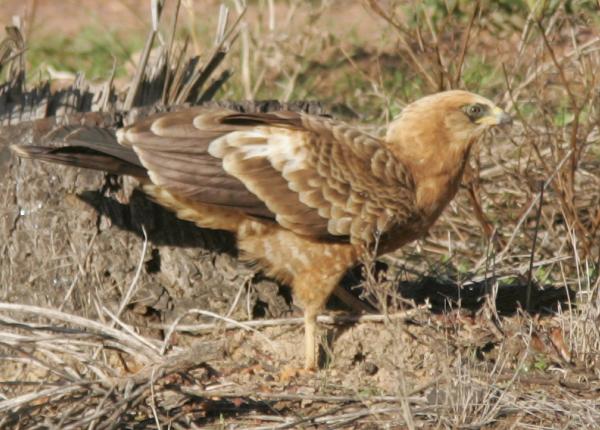Did You Know?
- The African Harrier-hawk is known by a few other names including African Gymnogene, Banded Harrier-hawk, and Bare-faced Whistling Hawk
- There are two recognized subspecies of the African Harrier-hawk
- This species has a reversible intertarsal ("knee") joint which can bend backward, as well as forward, enabling the bird to reach into deep holes to pull out any small prey animals hiding there.
How The Peregrine Fund is Helping
Though The Peregrine Fund doesn't work directly with African Harrier-hawks, our efforts in scientific research, habitat conservation, education, and community development help conserve raptors on a global scale. We also supply literature to researchers from our avian research library, which helps scientists around the world gather and share important information on raptor conservation. We also run the Global Raptor Impact Network which gives raptor researchers tools to more efficiently conduct their own studies while contributing to a global program. GRIN also provides citizen scientists a way to participate in raptor science and conservation.
Where They Live
Occurs in a wide variety of open and forested habitat, ranging from semi-desert scrub to riparian woodlands to lowland rainforest and including exotic tree plantings in southern Africa. Occurs in the vicinity of oil palms (Elaeis) palms in Uganda (Carswell et al. 2005). It is often associated with cliff faces in mountainous or hilly terrain in South Africa, but it also occurs in flat plains (Boshoff 1997). Less common in more arid areas. Usually perches within cover. Occurs singly or in pairs
Why They Need our Help
This lovely raptor is categorized as a species of Least Concern.
What They Eat
This raptor is a very opportunistic feeder. It will prey on small mammals, frogs, lizards, and insects, which are found by climbing around on tree trunks and limbs, peering into crevices and holes while hanging at odd angles. For prey that would otherwise be inaccessible, this species hangs under branches and cliffs, balancing with flapping wings, and feeding on anything that they come across. It raids nesting colonies of birds, taking eggs and nestlings. It also hunts on the wing, soaring or flapping slowly over open areas between trees. It also feeds on oil palm fruit, and takes carrion and fish, too.
Nests, Eggs, and Young
The male and female African Harrier-hawks work together to build a stick nest on rocks or trees. They will line the nest with green leaves. The female will lay 2 eggs, which are white and boldly blotched with dark reddish-brown markings. Both parents will help incubate the eggs. After about 36 days of caring for their eggs, the nestlings will hatch. After they do, the competition for survival is fierce and often the larger, stronger nestling will kill its smaller, weaker sibling. Over the next 52 days, the nestlings will grow quickly. Their feathers will grow in and they will gain strength as they prepare to fly from the nest for the first time.
African Harrier-hawk and the World Center for Birds of Prey
The World Center for Birds of Prey offers fun ways to learn about birds of prey. Interactive activities, tours, interesting videos and a children's room with activities from coloring sheets to quizzes to costumes are all available for our guests. We also have knowledgeable, on-site staff to answer any questions you may have about African Harrier-hawks or any other bird of prey.
References:
Global Raptor Information Network. 2022. Species account: African Harrier-hawk Polyboroides typus. Downloaded from http://www.globalraptors.org on 28 Nov. 2022
Kemp, A. C. and J. S. Marks (2020). African Harrier-Hawk (Polyboroides typus), version 1.0. In Birds of the World (J. del Hoyo, A. Elliott, J. Sargatal, D. A. Christie, and E. de Juana, Editors). Cornell Lab of Ornithology, Ithaca, NY, USA. https://doi.org/10.2173/bow.afhhaw1.01










